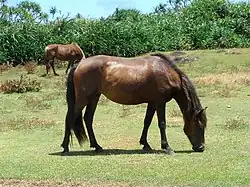Yonaguni horse
.jpg) | |
 | |
| Conservation status | FAO (2007): critical |
|---|---|
| Country of origin | Japan |
| Distribution | Yonaguni Island |
| Traits | |
| Height | |
The Yonaguni (Japanese: 与那国馬, yonaguni uma) is an endangered Japanese breed of small horse. It is native to Yonaguni Island, in the Yaeyama Islands in south-western Japan, close to Taiwan. It is one of eight horse breeds native to Japan and – like most other Japanese native breeds – is critically endangered.[3]
History
Japanese native horses are thought to derive from stock brought at several different times from various parts of the Asian mainland; the first such importations took place by the sixth century at the latest.[4] Horses were used for farming – as pack-animals although not for draught power; until the advent of firearms in the later sixteenth century, they were much used for warfare.[3]: 67 The horses were not large: remains of some 130 horses have been excavated from battlefields dating to the Kamakura period (1185–1333 AD); they ranged from 110 to 140 cm in height at the withers.[3]: 67
In 1968 there were 210 Yonaguni horses. By the early 1980s, the number had fallen to little more than fifty; numbers subsequently recovered slightly.[3]: 94 The conservation status of the breed was listed as "critical" by the Food and Agriculture Organization of the United Nations in 2007.[5]: 71 No population data has been reported to DAD-IS since 2008, when the breed numbered 85 head,[2] up from a low of 48 individuals recorded in 1977.[3]: 94 In 2025 its conservation status was unknown.[2]
In 2003, genetic analysis using microsatellite data found the Yonaguni to be most closely related to the Miyako and Tokara small-island breeds, and less closely related to various Mongolian horse breeds than were the Dosanko and Kiso breeds of the main islands of Japan.[6]: 378
Characteristics
Like the other Japanese island breeds, the Yonaguni is small. Heights at the withers are in the range 102–122 cm.[1]: 514
References
- ^ a b Valerie Porter, Lawrence Alderson, Stephen J.G. Hall, D. Phillip Sponenberg (2016). Mason's World Encyclopedia of Livestock Breeds and Breeding (sixth edition). Wallingford: CABI. ISBN 978-1-78064-794-4
- ^ a b c d Breed data sheet: Yonaguni / Japan (Horse). Domestic Animal Diversity Information System of the Food and Agriculture Organization of the United Nations. Accessed July 2025.
- ^ a b c d e [Editorial Committee Office of the Japanese Country Report, Animal Genetic Resources Laboratory, National Institute of Agrobiological Sciences, Japan] ([n.d.]). Country Report (For FAO State of the World’s Animal Genetic Resources Process); annex to: The State of the World's Animal Genetic Resources for Food and Agriculture. Rome: Commission on Genetic Resources for Food and Agriculture, Food and Agriculture Organization of the United Nations. ISBN 978-92-5-105762-9. Archived Accessed 15 October 2012.
- ^ Japanese Native Horses. International Museum of the Horse. Archived 22 August 2010.
- ^ Barbara Rischkowsky, Dafydd Pilling (editors) (2007). List of breeds documented in the Global Databank for Animal Genetic Resources, annex to: The State of the World's Animal Genetic Resources for Food and Agriculture. Rome: Commission on Genetic Resources for Food and Agriculture, Food and Agriculture Organization of the United Nations. ISBN 978-92-5-105762-9. Archived 23 June 2020.
- ^ T. Tozaki, N. Takezaki, T. Hasegawa, N. Ishida, M. Kurosawa, M. Tomita, N. Saitou, H. Mukoyama (2003). Microsatellite Variation in Japanese and Asian Horses and Their Phylogenetic Relationship Using a European Horse Outgroup. Journal of Heredity. 94 (5): 374–380. doi:10.1093/jhered/esg079. (subscription required).